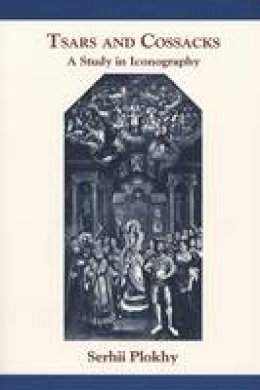
Tsars and Cossacks
Serhii Plokhy
Ukrainian Cossacks used icon painting to investigate their relationship not only with God but also their relationship with the Russian tsar. Could Emperor Peter I and his adversary in the Battle of Poltava (1709)—the Cossack Hetman Ivan Mazepa—be depicted in the same icon? Why did the Cossack colonels commission icons with the portraits of their tsars, but not of their own Cossack leaders, the hetmans? Could a Catholic king be portrayed in an Orthodox icon? Why are the Russian tsars and Orthodox hierarchs missing on some of the Zaporozhian Cossack icons?
In this groundbreaking study, Serhii Plokhy provides answers to these and many other questions pertaining to the political and religious culture of Ukrainian Cossackdom, as reflected in the Cossack-era paintings, icons, and woodcuts. By encouraging the iconography to “speak,” Tsars and Cossacks helps to broaden and deepen our understanding of Ukrainian iconography as well as Russian imperial political culture.
Product Details
About Serhii Plokhy
Reviews for Tsars and Cossacks
Carol B. Stevens
The Russian Review
Serhii Plokhy’s Tsars and Cossacks: A Study in Iconography explores the complex interaction of the political, religious, and artistic aspects of the iconographic types of the Pokrova, the protective mantle of the Mother of God, as it evolved in the Ukrainian lands during the seventeenth and eighteenth centuries. This cameo of a book of just seventy-five pages offers the reader a rich view of a society in transition… On the whole, Plokhy’s ideas are as original as is his argument well-substantiated. Above all, one would heartily welcome a work of such fine quality dedicated to the history of a European people that even until now largely remains an ‘unexpected nation’ to the West.
L. V. Charipova
Slavic and East European Review
Serhii Plokhy’s study of the ideology and rhetoric of icons of the Pokrova (the Holy Protection of the Mother of God) presents the reader with a most engaging marriage of meticulous historical argument with the intrigue and suspense of the detective novel… Tsars and Cossacks…adds richly to our understanding of the political and cultural force fields that bore on Cossack Ukraine. It also provides a welcome example of the wealth of historical insight that can be gained from serious and detailed engagement with cultural artifacts, and demonstrates that even the most erudite historical writing can be appealing and accessible.
Marko Pavlyshyn
Australian Slavonic and East European Studies
